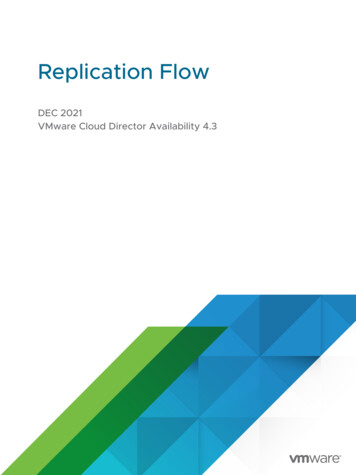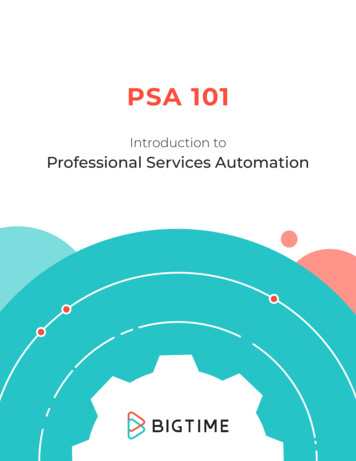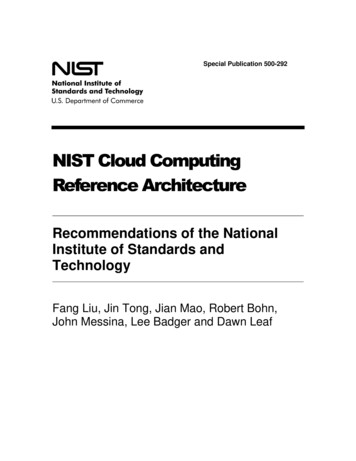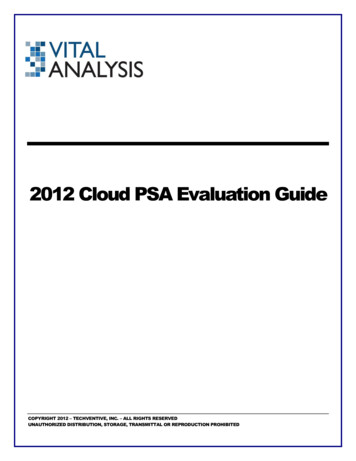
Transcription
2012 Cloud PSA Evaluation GuideCOPYRIGHT 2012 – TECHVENTIVE, INC. – ALL RIGHTS RESERVEDUNAUTHORIZED DISTRIBUTION, STORAGE, TRANSMITTAL OR REPRODUCTION PROHIBITED
PSA EVALUATION GUIDETable of ContentsTable of Contents .2Introduction .3When to Replace Your PSA System .7Getting Organized .12Macro Selection Considerations .18Selection Process Today.28Short Listing .34Software Demonstration .37Decision Making .44Selling the Decision.51Appendix .53COPYRIGHT 2012 – TECHVENTIVE, INC.2UNAUTHORIZED DISTRIBUTION, STORAGE, TRANSMITTAL OR REPRODUCTION PROHIBITED
PSA EVALUATION GUIDEIntroductionBrief History of Project and Service SolutionsGenealogy of Project and Service SolutionsService organizations have not enjoyed the 4 decades of packaged software solutions that have beenavailable to manufacturers and other entities. Custom, bespoke solutions have figured greatly inservice organizations during this time frame. Spreadsheets, PC-based applications and components oflarger ERP suites have rounded out the software portfolio of countless service firms globally.In the 1980s, firms like VisiCalc and Lotus produced spreadsheet tools that ushered in a new level ofproductivity, accuracy and planning for project-based activities. In subsequent years, Microsoft andother firms expanded this capability into project planning software and project management systems.These project planning/management solutions greatly aided efforts in developing work plans,determining critical path activities, identifying schedule conflicts and other project managementactivities.During that same time frame, some financial and ERP software vendors created project accountingsoftware that utilized much of the same functionality found in their accounting modules. Thesesystems kept track of the cost and expenses involved in project-based work.As these project and service-based solutions continued to evolve, the market saw more specializedsolutions enter the marketplace. For example, newer products could:-manage portfolios of projects for maximum ROI (PPM – Project Portfolio Management)-manage shared resources across multiple projects (Collaboration and Project Tracking)-track and prioritize Research &Development efforts and their stage gates (NPD – NewProduct Development)-assist internal (often, IT) groups manage their projects, operations and the value they deliverto their internal stakeholders (ISM – Internal Service Management)-calculate earned value and other metrics (Project Management Software)COPYRIGHT 2012 – TECHVENTIVE, INC.3UNAUTHORIZED DISTRIBUTION, STORAGE, TRANSMITTAL OR REPRODUCTION PROHIBITED
PSA EVALUATION GUIDE-generate reports, bills and costing data to satisfy different regulatory and governmentcontracting requirements (Contracting Software)-facilitate coordination between different trades and disciplines (Collaboration, ProjectManagement and Design Engineering Support Software)-manage the full lifecycle of project from design, construction and long-term operation andmaintenance (Project Lifecycle Management)But even with all of this positive evolution, some software shortfalls existed. Many service firms, forexample, wanted software solutions that:-did more than just (or simply) plan and track a project-worked well in the field with remote project teams-came with their own fully integrated accounting solution-permitted easy entry of information from contractors and other third-parties-eliminated many redundant sources of data entry (e.g., the need to enter time and expensesinto separate project tracking, project accounting/billing and travel expense reimbursementsystems)-were designed first and foremost for service organizations and were not a retrofit of asolution designed originally for hard industries (e.g., manufacturing)Around 1998, at the end of the client/server era, a new generation of software products began toemerge. These products would become known as Professional Service Automation (PSA)technologies. PSA products contain core functionality, missing from many ERP suites, that is essentialfor a well running, efficient service organization. For example, PSA solutions often possess capabilitiessuch as:-Resource Management -- Resource Management deals with the number one asset and costcomponent of a service organization: its workforce. Resource management, at a minimum,helps executives determine who the best suited individuals to complete a project are andwhat their availability is. Done well, resource management can have a tremendous impact onchargeability, client satisfaction and utilization of personnel. When the right people areplaced on projects at the right time, work should be completed at or ahead of time and at orbelow budget.-Pipeline Management – Pipeline Management gives service organization executives forwardlooking visibility into future chargeability. Executives should be able to plan for project teammember substitutions, billing rate changes, training commitments for their staff, etc. Theimpact of these changes should be easy to enter, review and forecast.COPYRIGHT 2012 – TECHVENTIVE, INC.4UNAUTHORIZED DISTRIBUTION, STORAGE, TRANSMITTAL OR REPRODUCTION PROHIBITED
PSA EVALUATION GUIDEPSA solutions are continuing to evolve. Virtually all PSA products today are cloud-based solutions.Many are multi-tenant applications that require little capital investment and ongoing maintenancesupport from the service organizations they serve.The modern PSA solution is being embraced by more kinds of businesses and service organizationsthan in the past. Previously, early PSA solutions found a strong following with accounting firms, lawfirms, IT consultancies and other professional service firms like architects. In the last decade, ascompanies of all kinds have tried to grow revenue, these firms have created new revenue sourcesthrough the sale and delivery of add-on services. New PSA customers are coming from business unitswithin retailers, oil and gas firms, software companies, manufacturers and many other sources.Because service revenue is becoming a growing and important part of many business’ income stream,interest in solutions that will help manage and profitably grow these revenue streams is on theuptake.Today's PSA system should contain modules that support:-Resource ManagementIntegration with Microsoft Excel and Microsoft ProjectClient BillingTime TrackingTime EntryProject AccountingProject TrackingMobile SupportExpense ManagementCollaboration (especially with clients, contractors and other third-parties)These new solutions have significant functionality to support mobile computing devices such as cellphones and tablet computers. Likewise, powerful platform computing environments are propellingthe development of new PSA solutions as well as thousands of complementary add-on functionalapplications built by all-new armies of independent software developers.Mergers and Acquisition in the Project Software SpaceThe PSA market is currently expanding and contracting. ERP vendors have acquired a number ofpreviously independent PSA solution providers.This market activity points to several positive developments along with a couple of cautionary points.On the plus side, it shows that the PSA market is gaining in relevance. When larger ERP providers areacquiring PSA solutions, it indicates that these software vendors see additional growth in the servicesspace. Moreover, ERP vendors are signaling that more of their growth will come from sectors that arealso growing (like services).On the other side, the history of mergers and acquisitions in the software industry is a bit of a mixedbag. While company founders and shareholders often benefit, software customers sometimes canCOPYRIGHT 2012 – TECHVENTIVE, INC.5UNAUTHORIZED DISTRIBUTION, STORAGE, TRANSMITTAL OR REPRODUCTION PROHIBITED
PSA EVALUATION GUIDEend up on the short end of the receiving stick. In the PSA space, an acquisition is generally not a badthing. However, the best acquisitions will be those where the ERP vendor and the PSA vendor bothshare a common technical architecture. For some acquisitions, the common architecture may neveroccur. For some, it may occur over time. And for some, like FinancialForce and its acquired product,the two product lines were built on the same Platform-as-a-Service (PaaS). It is the latter category thatmay possess the most benefit to customers short and long-term.SRP – Services Resource PlanningIn the last few years, a new term has emerged: SRP (Services Resources Planning). SRP represents abroader scope and value proposition than PSA. Generally, SRP refers to PSA and additional softwareproducts that complete more of the business needs of project oriented businesses. SRP solutionsoften include additional software for:-Accounts PayableFixed AssetsGeneral LedgerAccounts ReceivableCredit & CollectionsPurchasingPayrollHuman Resources (HR) ComplianceRecruiting/Talent AcquisitionCustomer Relationship Management (CRM)Sales Force AutomationSoftware vendors often begin their product line with 1-2 applications and then add more modules orapplications over time. Usually, these vendors add solutions that complement their existingapplications. The new applications usually appear on the periphery of their existing solutions. PSAproduct lines are growing and, hence, morphing into ever larger software suites. SRP is evidence of atrend where service firms can now experience the full, complete application suites that ERP(Enterprise Resource Planning) users (e.g., manufacturers) could enjoy.For the purpose of this guide, we will stay focused on the core PSA application areas. Addingadditional content to cover these other modules adds considerable bulk to the guide. Also, many ofthe additional modules found in SRP solutions are covered by other publications Vital Analysis hasproduced on ERP and HR solutions.The Changing PSA BuyerAs this market continues to mature, buyers of PSA software are becoming savvier, too. They seesignificant differences between the products being marketed today and those from previousgenerations. They are being bombarded with a veritable lexicon of new product names, architecturaland technological attributes and other software characteristics that may confuse them for a time. YetCOPYRIGHT 2012 – TECHVENTIVE, INC.6UNAUTHORIZED DISTRIBUTION, STORAGE, TRANSMITTAL OR REPRODUCTION PROHIBITED
PSA EVALUATION GUIDEunderneath all of the buzzwords and marketing hype, there truly are pioneering firms with radicallynew and impressive products that are reshaping the PSA software space.Because of these changes in the market, we have crafted this quick buyer’s guide for cloud-based PSAsoftware. Our goal is to help the reader understand the very different choices, decisions andconsiderations they may need to make when deciding on their next PSA software solution. We havedefined some useful guidance within these pages to help you make a decision that serves yourorganization well for many years to come.This Buyer’s GuideWe have laid out this PSA Evaluation Guide to follow a multi-step process. We believe this process willallow your organization to become more aware of the PSA software marketplace and determine anew software solution partner.Each section of this guide highlights many of the major issues your organization should consider inmaking a PSA software selection ingTheDecisionWe hope this guide will:-help your organization get productive quicklycollapse many of the best ideas in PSA software solutions into one, easy-to-read,structured publicationaccelerate the selection team’s learning curvedefine and structure the PSA vendor selection processpreemptively address many of the issues the selection team will encounter in choosing aPSA solutionprovide practical guidance to making a PSA software solution choicemake you, the reader, more self-sufficient and successfulThis Buyer’s Guide is not a detailed methodology as it trades completeness for brevity. It does,however, serve as a quick reference guide for the selection team and provides a common frameworkfor communicating with them. Be sure to adapt the contents of this guide to your organization.Smaller organizations may not require as formal of a selection, for example. Larger organizations mayneed additional personnel, review points, etc.Enjoy.COPYRIGHT 2012 – TECHVENTIVE, INC.7UNAUTHORIZED DISTRIBUTION, STORAGE, TRANSMITTAL OR REPRODUCTION PROHIBITED
Section1When New PSA Software System is NeededWhat Kind of Service Organization Are You?How do you know if your organization needs a new PSA system? While every situation is unique, youmay find your service operation falling into one (or more) of the following categories.The Inconsistent Service OrganizationDoes every project team in your firm have its own way of selling projects, planning the work, trackingtime, recording expenses and/or preparing bills? Smaller service groups often start off this way butrealize this approach to business does not scale or scale well. Results are hard to predict. Cash flowmanagement is really difficult too. Staff get frustrated and are often underutilized. No one knowswhat opportunities exist or what the true pipeline is.In this world, there is no PSA. What systems there are usually include a smattering of diverse personalcomputer based (or free/low-cost Internet web applications) that are not integrated with each other.To understand the true status of any one project, data from multiple people’s personal computers,spreadsheets, time reports, status reports and other communications must be hunted down andanalyzed.This is a frustrating work environment for everyone. Team members spend too much time reconcilingdata and rekeying project information. No one really knows what is going on across the companybecause the data is too fragmented and hard to coalesce. Worse, few have confidence in the datathey do have. Customers are often frustrated, too. They may not get project status data for days,weeks or months AFTER the work has occurred.The inconsistent service organization needs PSA software if it wants to:-prosperbetter serve clients/customersimprove cash flowimprove worker productivityeliminate non-value (and non-chargeable) activityCOPYRIGHT 2012 – TECHVENTIVE, INC.7UNAUTHORIZED DISTRIBUTION, STORAGE, TRANSMITTAL OR REPRODUCTION PROHIBITED
PSA EVALUATION GUIDEThe Functioning Service OrganizationSome service organizations have never had a PSA (Professional Services Automation) solution.Typically, these organizations possess a collage of systems. These may include:-packaged financial accounting softwarea mix of package and custom human resources softwarePC-based project estimating and tracking toolsa different collaboration toola third-party expense management toolanother vendor’s CRM (Customer Relationship Management) solutiondozens or thousands of spreadsheetscustom built staffing and resource management technologyFor these firms, their current software portfolio has allowed them to function but rarely much morethan that. The solutions can be a mix of on-premise and cloud products. Few processes within theseservice organizations could be labeled as process excellent or world class. Some functions like timeand expense reporting may require multiple, redundant inputs into separate billing, project tracking,expense reimbursement and other systems.In short, service organizations with this patchwork of nonintegrated, multi-origin systems need a new,single, integrated PSA product if they want to:-perform as a high functioning service entityimprove productivity of service professionalsimprove productivity of (and reduce costs of) internal, non-chargeable personnel (e.g.,accounting and human resources)improve service levelsbecome more competitiveThe functioning service organization will rarely score well on benchmarks against its peers. Whilesome parts of the organization may shine, too many parts are suffering from the collectiveinefficiencies that a less than integrated collection of technologies may trigger. Functioning serviceorganizations just aren't as competitive as they could be.Service Organization in TransitionSome service organizations will require a PSA solution because the entity itself is undergoing asignificant transition or transformation. Some of the reasons behind such a transformation may bedue to organic growth or contraction of the business. In other words, the firm may have outgrown thetechnologies that served it well when it was a much smaller entity. Likewise, inorganic changes, suchas mergers, acquisitions or divestitures, may mandate the need for a new or singular set of solutions.COPYRIGHT 2012 – TECHVENTIVE, INC.8UNAUTHORIZED DISTRIBUTION, STORAGE, TRANSMITTAL OR REPRODUCTION PROHIBITED
PSA EVALUATION GUIDEService Organization With No Prior PSA SolutionWhen a new service operation is launched, service operation executives will often try to createcustom makeshift solutions (e.g., spreadsheets). These sub optimal solutions may serve a validbusiness purpose for the short-term; however, these are not the underpinnings of a successful longterm service operation.These solutions are often inadequate as they:--do not scale well, if at all. Spreadsheets might suffice for a very small, local service firmbut fail once the company adds headcount, expands into new geographies, etc.have the potential for keying and other errors. The data within these systems may,despite the best efforts of those using them, lack the integrity, reliability and accuracythat external auditors, bankers, customers and others require.are difficult to debug or correctThe presence of these temporary solutions is not in and of itself a problem. Rather, they simplyrequire a decision as to when their replacement will occur. A new PSA solution will be required atsome point if this service operation begins to grow.Product Firm With Unsupported Service OrganizationService revenues are a growing part of many firms, especially firms traditionally focused on the sale ofproducts. Unfortunately, the information systems that were designed for one kind of business (e.g.,manufacturing) may be inadequate, incomplete and ineffectual in the operation of a world-classservice firm.For captive service organizations, these entities may:--use, for a time, a combination of the parent company’s ERP and custom applications.These customizations may include modifications to the ERP product, the use ofspreadsheets and/or the development of custom applications. The value of thismakeshift solution is often transitory. It allows for basic functions to be completed butlittle else. Should the service organization experience any modest market acceptance,this kludge will need to be replaced.use spreadsheets and other one-off temporary solutions (see above section “No PriorPSA Solution”)In time, the captive subsidiary or business unit will need a PSA solution to support its operations,audit, revenue recognition and other requirements.COPYRIGHT 2012 – TECHVENTIVE, INC.9UNAUTHORIZED DISTRIBUTION, STORAGE, TRANSMITTAL OR REPRODUCTION PROHIBITED
PSA EVALUATION GUIDEService Organization Striving to Become A Market LeaderSome service operations are well-run and well-managed. They have great systems and they achievetop quartile results across their competitive peer group. The service entities are clearly processexcellent.To move beyond process excellence, the service entities will need to focus on gaining insights intotheir business in ways that competitors cannot. What this implies is that these firms must have asingle, integrated technology suite where all information is extensible, accessible and connected topowerful reporting, analytic and other tools. If the information is disjointed, then errors, latency andother data quality concerns will frustrate executives as they try to achieve market leadership position.To illustrate, there are very well-run service operations that still have great difficulty gettingagreement across their different practice units globally. Can your firm agree on what the definitionsand calculations are for chargeability, utilization, backlog, write offs, gross margin, net margin andother factors? Inconsistencies in how service entities account for time, revenue, vacation, training,etc. make it very hard to consistently and accurately optimize these entities on a large scale.Implementing a PSA solution does not solve these problems per se; however, the implementation ofthese technologies often forces these issues to the front and helps facilitate the development of agreat global service organization.Other Change TriggersSome service firms experience a different kind of transition that is difficult to pull off with less thancapable PSA components. For example, your service organization may be undergoing one of thefollowing changes:---From local market focus to industry specializations - Frequently, service entities discoverthat different practice locations have different solutions which may be configureddifferently across geographies and lack the ability to scale. Solutions that are optimizedfor tiny micro markets may not be suitable for a service organization that wants toprovide the best and brightest resources on a national or global basis. PSA software,especially the resource management capabilities, can greatly enable this migration.From “Lone Wolf” sales practices to team selling - Many successful service organizationspossess a “eat what you kill” approach to service sales and delivery. In this environment,capabilities such as collaboration, resource management and other functions may beminimal or nonexistent. However, should this service organization wish to gain additionalsynergies from team selling and better utilization of resources across teams, then a PSAsolution may be required.From loose confederations to a single global firm - For many reasons, some firms (e.g.,accountancies) have different legal structures in the various parts of the world in whichthey operate. Moreover, while the different legal entities may share some commonplanning and marketing activities, the systems are frequently unique at each practiceCOPYRIGHT 2012 – TECHVENTIVE, INC.10UNAUTHORIZED DISTRIBUTION, STORAGE, TRANSMITTAL OR REPRODUCTION PROHIBITED
PSA EVALUATION GUIDEcomponent level. For those companies moving away from a confederation style ofbusiness, a single, global, accessible PSA solution may be required.No matter what the trigger is behind the transition, the continued use of too many obsolete, differentor ill-suited service software solutions will only make a future PSA transition even more difficult.Other System ConcernsAs mentioned above, the legal entity structure of certain service operations can introduce a numberof operational and technical requirements with any systems decision.Service firms that are partnerships have some interesting factors that must be considered in asoftware evaluation. Let's examine one of these in more detail.Partnerships and CapitalIn a partnership, especially a long running partnership, there are often new partners being promotedevery year while other partners are retiring and leaving the firm. This ebb and flow of ownership canhave some interesting implications on technology decisions. From a funding perspective, IT projectswithin a partnership are often funded out of current year earnings. Even though the accountingtreatment for these projects may be listed as a capital expense, the firm cannot pay earnings topartners as the cash to do so may have already been committed to a software company and/orimplementation consultants. In other words, service partnerships abhor large IT capital projectsbecause they can adversely affect current year earnings distributions.New, freshly minted, partners are usually at the bottom of the income pool. Moreover, they mustincur significant hits to their current year income to offset the demands placed on them by thepartnership to fund their initial capital stake in the company. Bottom line, new partners are cashstrapped and do not like to start their partnership tenure with additional capital demands to fund newsystems.Likewise, partners that are about to retire do not want to see current year earnings being used tofund long-term capital investments. These individuals, often the most senior and influential membersof the firm, may attempt to delay or defer large IT capital expenditures as long as possible. In this way,these partners can maximize their last years’ earnings while pushing off the IT capital expenditure to adifferent generation of partners.Cloud-based systems, as most PSA systems are today, do not require as heavy of an upfront capitalexpenditure as prior on-premise systems did. Cloud-based systems generally do not require large upfront license fees and other immediate hits to a partnership’s current year earnings or cash flow. Forthis reason, cloud-based solutions may represent a more amenable technology choice for servicepartnerships.COPYRIGHT 2012 – TECHVENTIVE, INC.11UNAUTHORIZED DISTRIBUTION, STORAGE, TRANSMITTAL OR REPRODUCTION PROHIBITED
Section2Getting ingTheDecisionGuidelines for Getting OrganizedThree distinct groups must be convened in most software technology selections: organizationexecutives (e.g., practice leaders), functional users (e.g., Finance) and IT. Many other participantsmay also serve important functions during some or all of the selection effort:Figure 1COPYRIGHT 2012 – TECHVENTIVE, INC.12UNAUTHORIZED DISTRIBUTION, STORAGE, TRANSMITTAL OR REPRODUCTION PROHIBITED
PSA EVALUATION GUIDEMost every successful software selection has a core selection team. Smaller organizations may notrequire more than this group. In fact, the core team size should be commensurate with the size andcomplexity of your organization. Larger, more complex entities will want more input, more consensusand more guidance.The following text illustrates the team composition a large entity may utilize.A large organization will likely need a core selection team, a steering committee and input fromseveral business unit users.The core selection team will likely contain senior executives from:-Practice LeadersFinanceITProcurementLegalOperationsThese individuals are responsible for articulating the organization’s strategic vision, identifyingpotential organization changes (that could affect a software selection decision), developing theparameters for a shortlisted PSA solution, performing much of the due diligence and, making the keyrecommendations to the executive and/or steering committee. In sales parlance, this grouprepresents decision makers and influencers.The core selection team should also be supplemented with critical subject matter experts (SMEs) thatintimately understand the affected practice and resource management functions. These personsknow the unique organization issues/requirements, accounting nuances, regulatory requirements,integration concerns, needs of the broader user community and other factors that must beconsidered when evaluating new PSA and enterprise software solutions. These individuals will likelybe major contributors to the deeply functional aspects of the selection documents, selection processand detailed evaluation of the long and short-listed vendors.Practice Leaders are needed to:-identify critical business requirements-decide critical practice management issues (e.g., how utilization will be consistentlycalculated and reported)-design the operating and management structures (e.g., how different practice groups willroll up into the industry structure of the firm)-ensure that new software will be used by the practice professionals (i.e., facilitate asuccessful change management effort)COPYRIGHT 2012 – TECHVENTIVE, INC.13UNAUTHORIZED DISTRIBUTION, STORAGE, TRANSMITTAL OR REPRODUCTION PROHIBITED
PSA EVALUATION GUIDE-validate system, process and control designs when/if appropriate-support training and rollout activitiesA Finance executive is needed for several important roles. This individual should:-analyze the effect of the proposed solutions on the capital and operating budget of theorganization-document the effect that any solution has on the free cash flow of the organization-assess the process impacts of any new solution on company personnel-provide valuable context on how project profitability, margin and other metrics will becalculated and reported-ensure adequate controls will be in place-assess any solution specific (or implementation specific) risks that could expose theorganization to unwanted harmFinance also has a critical role to play during due diligence. A careful review of the corporate healthand viability must be undertaken for each of the sho
The PSA market is currently expanding and contracting. ERP vendors have acquired a number of previously independent PSA solution providers. This market activity points to several positive developments along with a couple of cautionary points. On the plus side, it shows that the PSA market is gaining in relevance. When larger ERP providers are


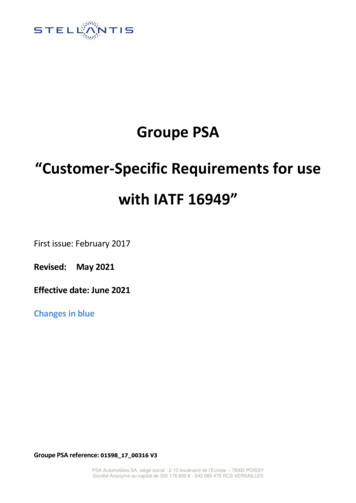
![Profile E01 PSA Width: 0.070 [1.8] inches [mm] Rectangle](/img/42/e01-to-e11-3.jpg)


